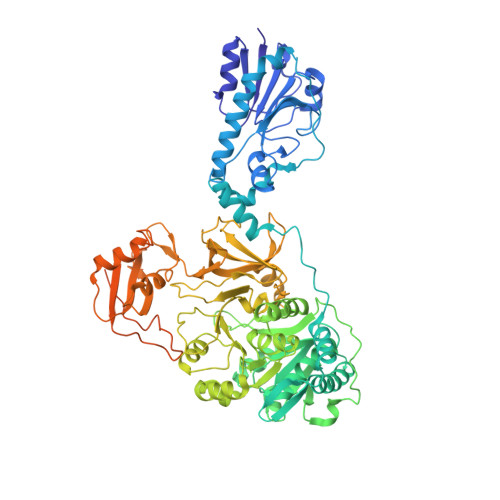Synthetic cycle of the initiation module of a formylating nonribosomal peptide synthetase.
Reimer, J.M., Aloise, M.N., Harrison, P.M., Schmeing, T.M.(2016) Nature 529: 239-242
- PubMed: 26762462
- DOI: https://doi.org/10.1038/nature16503
- Primary Citation of Related Structures:
5ES5, 5ES6, 5ES7, 5ES8, 5ES9 - PubMed Abstract:
Nonribosomal peptide synthetases (NRPSs) are very large proteins that produce small peptide molecules with wide-ranging biological activities, including environmentally friendly chemicals and many widely used therapeutics. NRPSs are macromolecular machines, with modular assembly-line logic, a complex catalytic cycle, moving parts and many active sites. In addition to the core domains required to link the substrates, they often include specialized tailoring domains, which introduce chemical modifications and allow the product to access a large expanse of chemical space. It is still unknown how the NRPS tailoring domains are structurally accommodated into megaenzymes or how they have adapted to function in nonribosomal peptide synthesis. Here we present a series of crystal structures of the initiation module of an antibiotic-producing NRPS, linear gramicidin synthetase. This module includes the specialized tailoring formylation domain, and states are captured that represent every major step of the assembly-line synthesis in the initiation module. The transitions between conformations are large in scale, with both the peptidyl carrier protein domain and the adenylation subdomain undergoing huge movements to transport substrate between distal active sites. The structures highlight the great versatility of NRPSs, as small domains repurpose and recycle their limited interfaces to interact with their various binding partners. Understanding tailoring domains is important if NRPSs are to be utilized in the production of novel therapeutics.
Organizational Affiliation:
Department of Biochemistry, McGill University, 3649 Promenade Sir-William-Osler, Montr¨¦al, Qu¨¦bec H3G 0B1, Canada.















